Crocoite is a rare mineral classified as a lead chromate (PbCrO₄). It is well-known for its vibrant orange-red color and distinctive crystal formations, which often occur as prismatic crystals or granular masses. Belonging to the chromate mineral group, crocoite is sought after by collectors for its brilliant color and unique appearance. It ranks between 2.5 and 3 on the Mohs hardness scale, indicating that it is relatively soft and fragile.

Chemical Composition:
Crocoite’s chemical formula is PbCrO₄, which means it is composed of lead (Pb) and chromate (CrO₄). The presence of chromium is what gives crocoite its striking orange to red color. It crystallizes in the monoclinic crystal system, typically forming long, slender, and fragile crystals. Due to its lead content, crocoite should be handled with care to avoid any potential health risks associated with lead exposure.
Discovery and Naming History:
Crocoite was first discovered in the Ural Mountains of Russia in 1766. It was initially mistaken for a red lead ore, but later analyses identified it as a unique mineral. The mineral was named “crocoite” in 1832 by French mineralogist François Sulpice Beudant, deriving its name from the Greek word “krokoeis,” which means “saffron-colored,” in reference to its distinctive hue. Since its discovery, the most notable and well-formed specimens have been found in the Dundas region of Tasmania, Australia, making it a classic locality for this mineral.
Contents
Physical and Chemical Properties of Crocoite
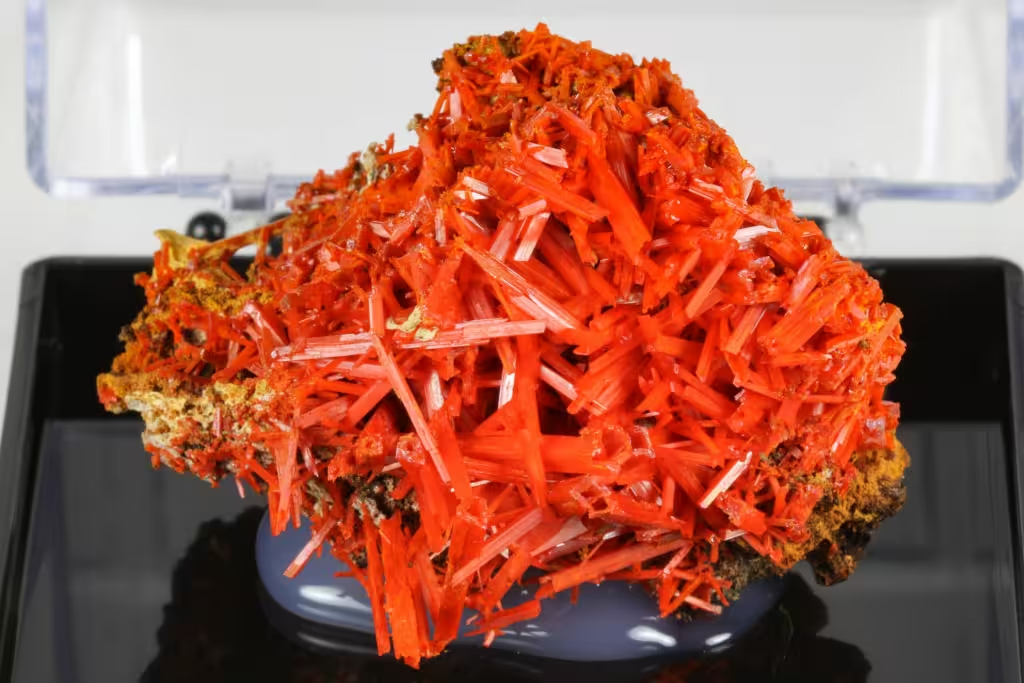
Physical Properties:
- Color: Crocoite is known for its vibrant orange-red to reddish-orange color, which can sometimes have yellow or orange tones. This distinctive color is due to the presence of chromium in its chemical structure.
- Crystal System: Monoclinic. Crocoite typically forms elongated, slender prismatic crystals, often with striations along their lengths. These crystals can be transparent to translucent.
- Luster: The mineral exhibits an adamantine to vitreous luster, giving it a shiny, glass-like appearance on crystal faces.
- Cleavage: Crocoite has perfect cleavage in one direction, making it relatively easy to split along certain planes.
- Fracture: When broken, it displays an uneven or conchoidal fracture pattern, which is characteristic of brittle materials.
- Hardness: Crocoite ranks between 2.5 and 3 on the Mohs scale of hardness, meaning it is relatively soft and can be scratched by most common materials, including a fingernail.
- Specific Gravity: The specific gravity of crocoite ranges from 5.9 to 6.1, which is considered quite high due to its lead content.
- Transparency: The mineral can range from transparent to translucent, allowing light to pass through to varying degrees.
- Streak: Crocoite leaves an orange-yellow streak when rubbed on a porcelain streak plate, which helps in identifying the mineral.
Chemical Properties:
- Chemical Formula: PbCrO₄ (Lead Chromate)
- Composition:
- Lead (Pb): 64.18%
- Chromium (Cr): 16.11%
- Oxygen (O): 19.71%
- Solubility: Crocoite is slightly soluble in dilute acids, which can release lead and chromium ions into the solution.
- Stability: The mineral is relatively stable under normal conditions but can be altered by exposure to water or humid conditions over long periods, causing it to degrade or oxidize.
- Reactivity: Due to its lead content, crocoite can react with certain chemicals, particularly acids, releasing toxic lead ions into the environment. Chromium, present in the form of chromate, can also pose environmental hazards if not handled properly.
- Toxicity: Crocoite is considered toxic due to its lead and chromium content. It should be handled with care, avoiding inhalation of dust or prolonged skin contact.
These properties make crocoite a unique mineral, both visually striking and chemically significant, but also one that requires careful handling due to its potential toxicity.
Uses and Applications of Crocoite
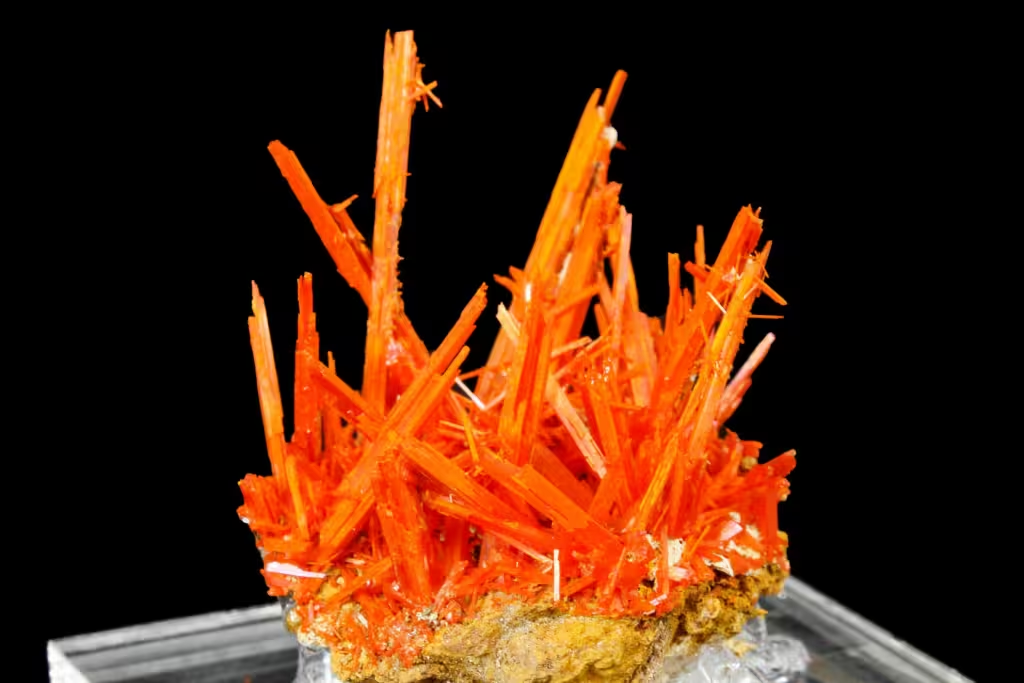
1. Collecting and Display: Crocoite is primarily valued as a collector’s mineral due to its vibrant orange-red color and striking crystal formations. High-quality crocoite specimens, especially those with well-formed crystals from classic localities such as Dundas, Tasmania, are highly sought after by mineral collectors and museums worldwide. These specimens are often displayed in mineral exhibitions or used for educational purposes to demonstrate mineralogical properties like color, crystal structure, and cleavage.
2. Ornamental and Decorative Uses: Though crocoite’s softness and fragility limit its use in jewelry, it is occasionally cut into cabochons or polished for use in unique pieces for display or decorative purposes. However, due to its lead content and delicate nature, crocoite is not a practical choice for everyday wear or handling.
3. Pigment Source (Historical Use): Historically, crocoite was used as a source of chromium for producing pigments. The bright red to orange hues of crocoite made it an ideal candidate for creating vibrant pigments used in paint and ceramics. However, with the advent of synthetic pigments and growing awareness of the health risks associated with lead and chromium exposure, crocoite is no longer used commercially for this purpose.
4. Scientific Research and Study: Crocoite is of interest in scientific research, particularly in mineralogy and geology, for studying the formation of chromate minerals in nature. Its unique properties, such as its crystallography and vibrant coloration, provide insights into geological processes and conditions that lead to the formation of lead chromate minerals.
5. Educational Uses: In educational settings, crocoite is used to teach mineral identification techniques, such as examining color, streak, hardness, and crystal form. Its distinct characteristics make it an excellent example for teaching the principles of mineral classification and chemical composition.
6. Environmental and Industrial Significance: While crocoite itself is not directly used in industrial applications, the study of its structure and formation has relevance in understanding the behavior of chromate compounds in the environment. Chromate compounds are important in various industrial processes, such as electroplating, dye production, and corrosion resistance coatings. Understanding the natural occurrences and stability of crocoite can help in managing chromium contamination and developing safer industrial practices.
Overall, crocoite’s main value lies in its appeal to mineral collectors, educators, and researchers, rather than in widespread practical applications due to its toxicity and fragility.
Formation and Occurrence of Crocoite
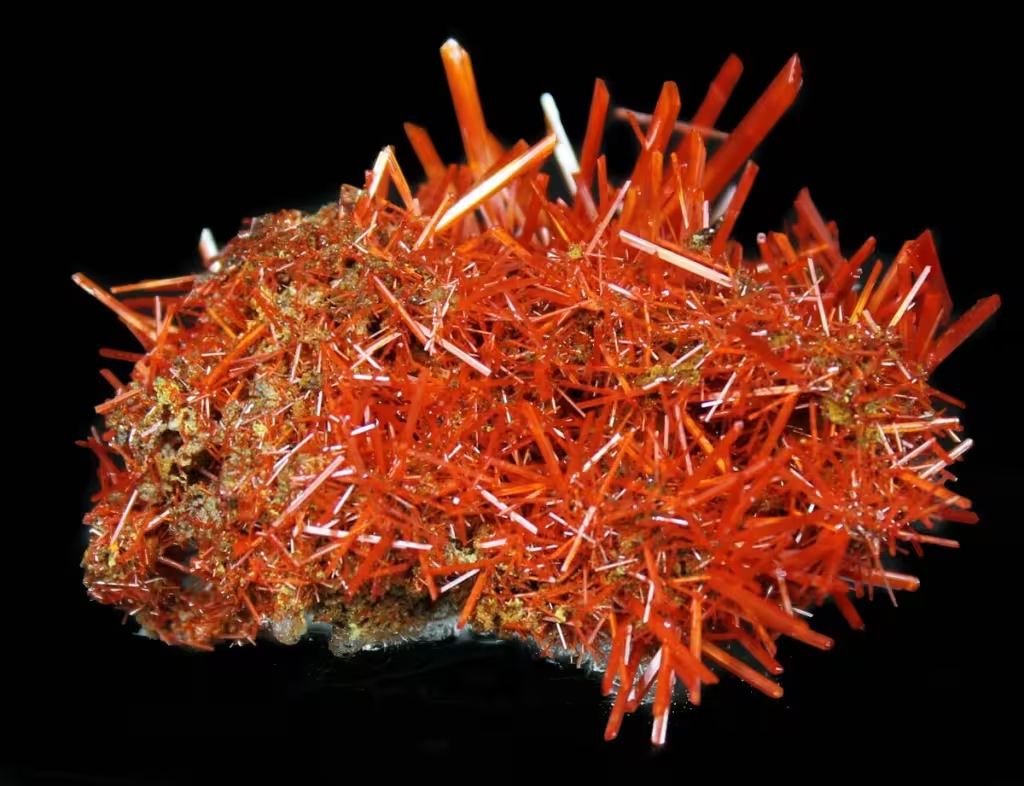
Geological Conditions for Crocoite Formation:
Crocoite forms under specific geological conditions that involve the alteration of lead-rich minerals in the presence of chromium-bearing solutions. The mineral typically occurs in the oxidation zones of lead ore deposits where conditions allow for the oxidation and precipitation of chromate ions.
Key conditions required for the formation of crocoite include:
- Presence of Lead-Rich Rocks: Crocoite forms in areas with substantial deposits of lead minerals, such as galena (PbS). When these lead-bearing rocks are exposed to oxygen-rich, oxidizing conditions, the lead can become mobilized and combine with available chromium.
- Chromium Source: The availability of chromium is crucial for crocoite formation. Chromium often originates from ultramafic rocks, such as serpentinites, or from chromium-rich hydrothermal fluids. These sources provide the necessary chromate ions (CrO₄²⁻) that react with lead in the oxidized zones.
- Oxidizing Environment: An oxidizing environment is essential for crocoite to form. In such environments, chromite (FeCr₂O₄) can oxidize to form soluble chromate ions, which then combine with lead ions in solution to precipitate crocoite. These conditions are often found in the upper parts of ore deposits where groundwater circulation facilitates oxidation.
- Low Temperature and Low Pressure: Crocoite typically forms at relatively low temperatures and pressures, which are common in near-surface environments. This mineral often crystallizes from low-temperature hydrothermal fluids that permeate lead-rich host rocks.
Common Mineral Associations:
Crocoite is often found in association with other secondary lead minerals and minerals that form in oxidizing environments. Common minerals associated with crocoite include:
- Cerussite (PbCO₃): A lead carbonate mineral often found alongside crocoite in the oxidation zones of lead deposits.
- Anglesite (PbSO₄): A lead sulfate mineral that forms through the oxidation of galena and can be found in the same deposits as crocoite.
- Vauquelinite (Pb₂Cu(CrO₄)(PO₄)OH): A rare mineral that can occur with crocoite, sharing a common chromium source.
- Embolite (Ag(Cl,Br)): A silver halide mineral occasionally found in the same areas as crocoite due to the presence of lead and silver-bearing veins.
- Galena (PbS): While galena is typically found deeper in the deposit, it serves as the primary source of lead from which crocoite and other secondary lead minerals are derived.
- Pyromorphite (Pb₅(PO₄)₃Cl): Another lead-based mineral that can be found in proximity to crocoite in oxidized lead deposits.
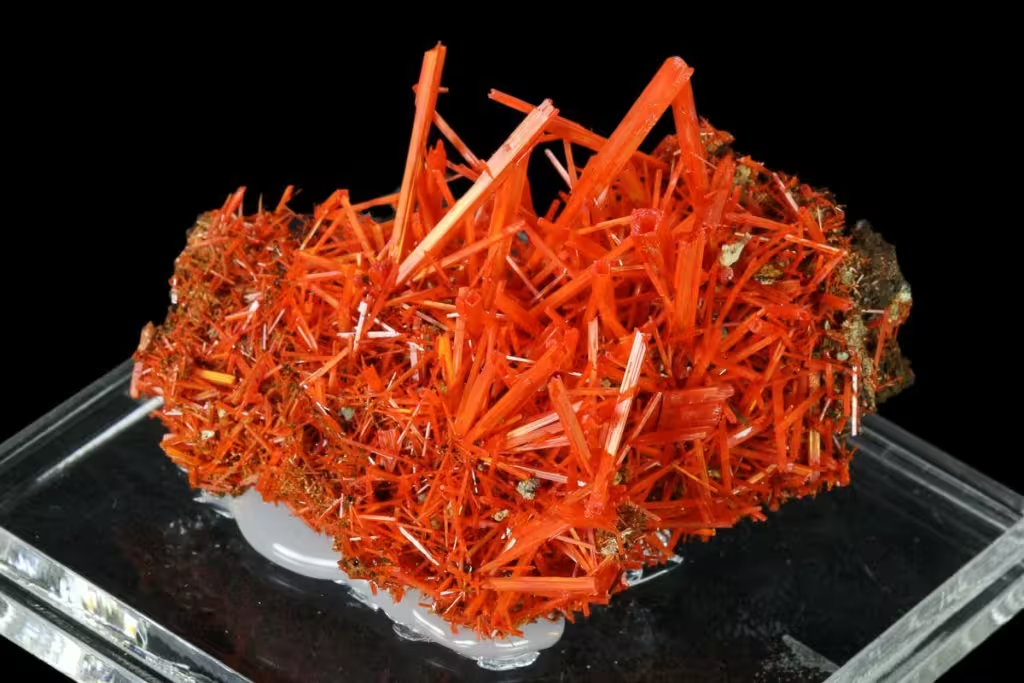
Famous Crocoite Localities:
- Dundas, Tasmania, Australia:
The Dundas region of Tasmania is the most famous and prolific locality for crocoite. Discovered in the late 19th century, the Red Lead and Adelaide mines in Dundas are renowned for producing the world’s finest crocoite specimens, characterized by their long, bright orange-red prismatic crystals. The unique geological conditions of this area, with chromium-rich ultramafic rocks in contact with lead deposits, provide an ideal environment for crocoite formation. - The Ural Mountains, Russia:
The Ural Mountains were the first recognized source of crocoite, discovered in 1766 near Berezovsk in the Perm region. While the Russian crocoite specimens are generally smaller and less vibrant than those from Tasmania, they are historically significant as the first-known occurrence of this mineral. - Callenberg, Saxony, Germany:
Crocoite has also been found in the Callenberg mining district of Saxony, where small but well-formed crystals have been recovered. These occurrences are less abundant than those from Tasmania or Russia but are noteworthy for their rarity in the European mineralogical landscape. - Arizona, USA:
In the United States, crocoite has been reported in small amounts from the Mammoth-St. Anthony Mine in Tiger, Arizona. However, these occurrences are relatively rare and do not compare to the specimens from Tasmania in terms of quality and size. - Other Localities:
Minor occurrences of crocoite have also been found in several other countries, including Brazil, South Africa, and the Philippines, though these are not as significant as the localities mentioned above in terms of specimen quality and abundance.
These famous localities highlight the rarity and unique geological conditions necessary for crocoite to form, making it a prized mineral among collectors and geologists.
Significance of Crocoite in Mineral Collecting
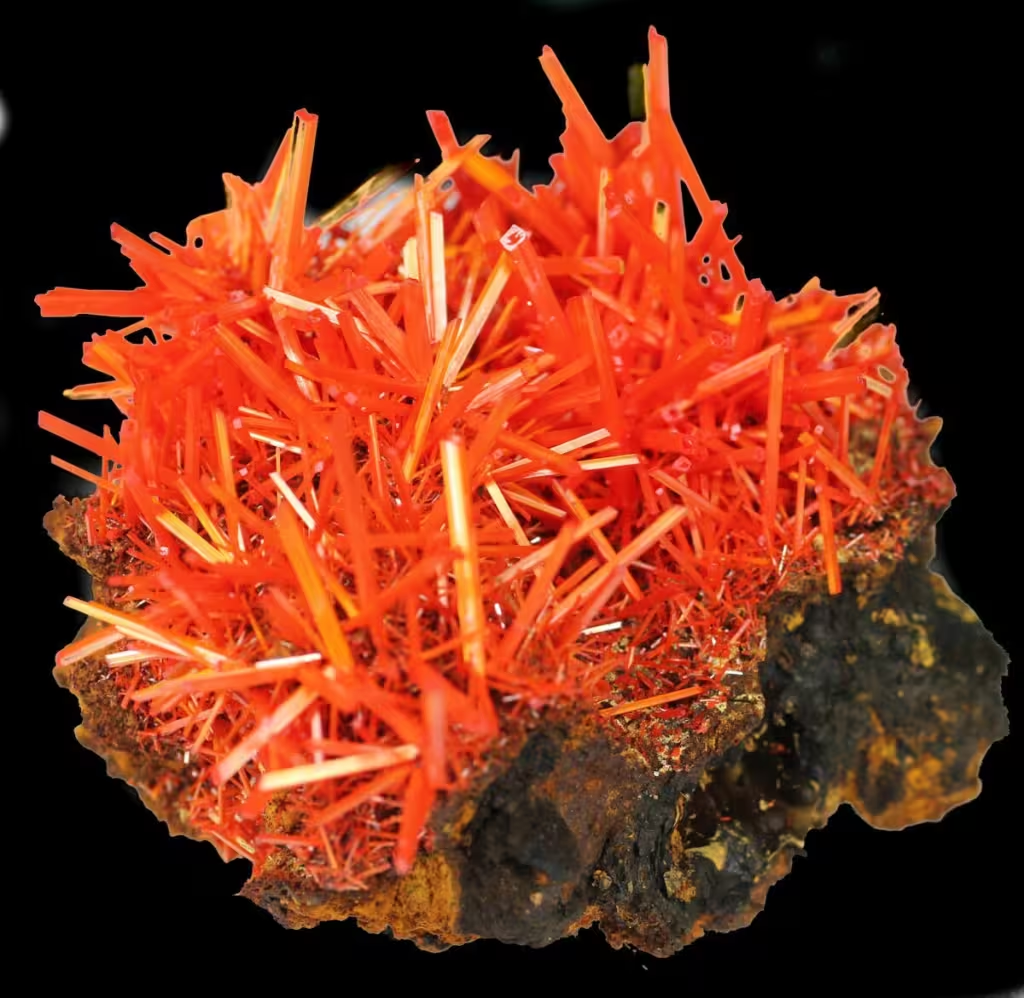
Unique Appearance and Appeal to Collectors:
Crocoite is highly prized among mineral collectors for its vibrant and striking appearance. Its intense orange-red to red color, combined with its distinctive, long, slender prismatic crystals, makes it one of the most visually stunning minerals. These crystals often have an adamantine to vitreous luster, which adds to their aesthetic appeal, making crocoite specimens stand out in any mineral collection. The mineral’s unique hue, attributed to the presence of chromium, sets it apart from other minerals, creating a dramatic contrast when displayed alongside other specimens.
Collectors are particularly drawn to crocoite specimens from classic localities like Dundas, Tasmania, which are known for their well-formed, large, and brilliantly colored crystals. These specimens are considered some of the finest in the world and are often the centerpiece of high-end mineral collections. The fragile, delicate nature of crocoite crystals also adds an element of rarity, as intact, undamaged specimens are less common and highly sought after.
Market Value and Rarity:
Crocoite is considered a rare mineral, especially when it comes to high-quality, well-formed crystals. The market value of crocoite varies widely depending on factors such as size, color intensity, crystal quality, locality, and overall condition. Specimens from the Red Lead and Adelaide mines in Dundas, Tasmania, are considered the most valuable due to their exceptional quality and unique formation. Large, vibrant, undamaged crystals with excellent color and clarity can command high prices, often ranging from several hundred to thousands of dollars, depending on the size and quality.
Because of its rarity and fragile nature, crocoite is considered an “exotic” mineral in the collecting community, adding to its desirability. Specimens from less well-known localities, such as those in Russia or Germany, are generally less valuable than those from Tasmania but still retain significant interest due to their historical significance and scarcity.
Preservation and Care Tips:
Due to its softness, brittleness, and susceptibility to damage, crocoite requires special care to preserve its beauty and integrity. Here are some tips for preserving and caring for crocoite specimens:
- Avoid Direct Handling: Crocoite crystals are delicate and can easily break or crumble if handled improperly. It is best to handle specimens minimally and always with clean, dry hands or with gloves to avoid transferring oils or moisture.
- Store in a Stable Environment: Crocoite should be stored in a cool, dry environment away from direct sunlight, which can cause the color to fade over time. Avoid humid conditions, as prolonged exposure to moisture can lead to degradation or oxidation of the mineral.
- Use Proper Display Techniques: When displaying crocoite, use stable, secure stands or mounts that do not put pressure on the fragile crystals. Placing the specimen on a padded or cushioned surface can help protect it from accidental knocks or vibrations.
- Avoid Exposure to Chemicals: Keep crocoite away from acidic or basic chemicals, as these can react with the mineral’s lead content and cause damage or discoloration. Dusting should be done gently with a soft brush, avoiding any cleaning solutions or water.
- Protect from Dust: Due to its fragility, crocoite is best displayed in a sealed glass or acrylic display case to protect it from dust, dirt, and accidental contact. A closed case also helps maintain a stable environment, shielding the mineral from fluctuations in humidity and temperature.
- Monitor for Deterioration: Regularly check crocoite specimens for any signs of deterioration, such as color fading, crystal flaking, or powdery residue on the surface. If deterioration is observed, consider storing the specimen in a more controlled environment or consulting a professional conservator for advice.
By following these care and preservation tips, collectors can maintain the beauty and value of their crocoite specimens, ensuring they remain stunning centerpieces in their collections for years to come.




































